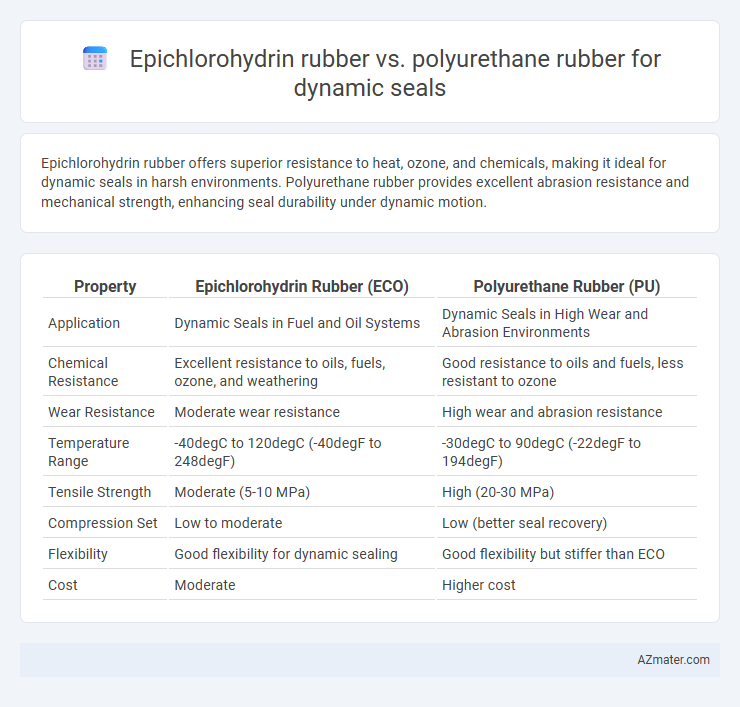Epichlorohydrin rubber offers superior resistance to heat, ozone, and chemicals, making it ideal for dynamic seals in harsh environments. Polyurethane rubber provides excellent abrasion resistance and mechanical strength, enhancing seal durability under dynamic motion.
Table of Comparison
| Property | Epichlorohydrin Rubber (ECO) | Polyurethane Rubber (PU) |
|---|---|---|
| Application | Dynamic Seals in Fuel and Oil Systems | Dynamic Seals in High Wear and Abrasion Environments |
| Chemical Resistance | Excellent resistance to oils, fuels, ozone, and weathering | Good resistance to oils and fuels, less resistant to ozone |
| Wear Resistance | Moderate wear resistance | High wear and abrasion resistance |
| Temperature Range | -40degC to 120degC (-40degF to 248degF) | -30degC to 90degC (-22degF to 194degF) |
| Tensile Strength | Moderate (5-10 MPa) | High (20-30 MPa) |
| Compression Set | Low to moderate | Low (better seal recovery) |
| Flexibility | Good flexibility for dynamic sealing | Good flexibility but stiffer than ECO |
| Cost | Moderate | Higher cost |
Introduction to Dynamic Seal Applications
Epichlorohydrin rubber offers excellent resistance to oils, chemicals, and weathering, making it ideal for dynamic seal applications in automotive and industrial machinery where exposure to hydraulic fluids is common. Polyurethane rubber provides superior abrasion resistance and high tensile strength, suitable for dynamic seals operating under high-pressure and wear-intensive environments such as pneumatic cylinders and heavy equipment. Selecting between Epichlorohydrin and Polyurethane depends on the specific operational conditions, including temperature range, chemical exposure, and mechanical stress in sealing systems.
Overview of Epichlorohydrin Rubber
Epichlorohydrin rubber, known for its excellent resistance to oil, ozone, and weathering, is widely used in dynamic sealing applications where chemical stability and flexibility are critical. Its low gas permeability and good mechanical properties make it a preferred choice for seals exposed to hydraulic fluids, fuels, and other aggressive chemicals. Compared to polyurethane rubber, epichlorohydrin offers superior resistance to swelling and environmental degradation, ensuring longer service life in dynamic sealing environments.
Properties of Polyurethane Rubber
Polyurethane rubber offers superior abrasion resistance, elasticity, and tensile strength compared to epichlorohydrin rubber, making it ideal for dynamic seals subjected to constant movement and pressure. Its excellent tear resistance and low compression set ensure longer service life and reliable sealing performance in hydraulic and pneumatic systems. Additionally, polyurethane's resistance to oils, fuels, and hydraulic fluids enhances its durability in harsh industrial environments.
Chemical Resistance Comparison
Epichlorohydrin rubber exhibits superior resistance to oils, ozone, and polar solvents, making it ideal for dynamic seals exposed to fuels and lubricants. Polyurethane rubber offers exceptional resistance to abrasion and hydrocarbon fuels but is more susceptible to degradation by acids and alkalis. For chemical environments involving organic solvents and moderate chemicals, Epichlorohydrin rubber provides enhanced durability and longevity in dynamic sealing applications.
Temperature Tolerance and Stability
Epichlorohydrin rubber exhibits excellent resistance to heat and thermal aging, maintaining stability up to temperatures of approximately 120degC, making it suitable for dynamic seals in moderate temperature environments. Polyurethane rubber, however, offers superior mechanical strength and can withstand higher peak temperatures up to 150degC while retaining elasticity and abrasion resistance under dynamic conditions. The choice between Epichlorohydrin and Polyurethane rubbers for dynamic seals depends on the specific temperature requirements and operational stability needed for the application.
Abrasion and Wear Performance
Epichlorohydrin rubber exhibits superior abrasion resistance and wear performance compared to polyurethane rubber, making it ideal for dynamic seal applications with high friction and continuous movement. Its chemical structure offers excellent resistance to oils and solvents, reducing degradation and extending seal life even under harsh conditions. Polyurethane rubber, although known for high tensile strength and flexibility, tends to wear faster in dynamic environments with abrasive particles, making epichlorohydrin a preferred choice for rigorous sealing applications.
Compression Set and Elasticity
Epichlorohydrin rubber exhibits superior compression set resistance compared to polyurethane rubber, maintaining dimensional stability under prolonged dynamic stress. Polyurethane rubber offers exceptional elasticity and tensile strength, enabling better recovery after deformation in dynamic seal applications. Compression set values for epichlorohydrin typically range from 15-25%, whereas polyurethane generally ranges from 20-30%, influencing seal performance in high-cycle environments.
Compatibility with Hydraulic Fluids
Epichlorohydrin rubber offers excellent compatibility with a wide range of mineral and phosphate ester-based hydraulic fluids, ensuring superior resistance to swelling and degradation in dynamic seal applications. Polyurethane rubber exhibits outstanding wear resistance and mechanical strength but has limited compatibility with ester-based hydraulic fluids, which may cause premature seal failure. Selecting epichlorohydrin is preferable for systems using diverse hydraulic fluids requiring long-term chemical stability and reliable sealing performance.
Cost-Effectiveness and Service Life
Epichlorohydrin rubber offers a cost-effective solution for dynamic seals due to its moderate initial price and good resistance to oils and weathering, extending service life in typical industrial environments. Polyurethane rubber, while generally more expensive upfront, provides superior wear resistance and abrasion durability, resulting in longer service life and reduced replacement frequency in high-stress applications. Choosing between Epichlorohydrin and Polyurethane rubbers depends on balancing budget constraints with the specific operational demands impacting seal longevity.
Selecting the Optimal Material for Dynamic Seals
Epichlorohydrin rubber offers excellent resistance to oils, weathering, and ozone, making it ideal for dynamic seals operating in harsh environments with moderate chemical exposure. Polyurethane rubber provides superior abrasion resistance and load-bearing capacity, ensuring longer seal life under high wear and dynamic stress conditions. Selecting the optimal material depends on specific application requirements such as chemical compatibility, mechanical stress, and environmental factors, with epichlorohydrin favored for chemical resilience and polyurethane preferred for mechanical durability in dynamic sealing solutions.

Infographic: Epichlorohydrin rubber vs Polyurethane rubber for Dynamic seal
 azmater.com
azmater.com